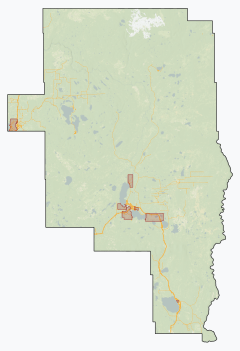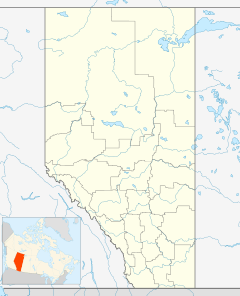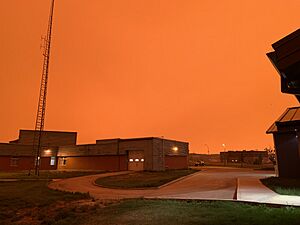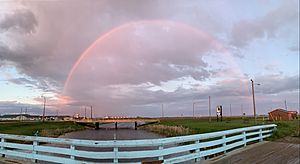Wabasca, Alberta facts for kids
Quick facts for kids
Wabasca
Wabasca-Desmarais
|
|
|---|---|
|
Hamlet
|
|
| Country | Canada |
| Province | Alberta |
| Region | Northern Alberta |
| Municipal district | Opportunity No. 17 |
| Area
(2021)
|
|
| • Land | 101.55 km2 (39.21 sq mi) |
| Elevation | 550 m (1,800 ft) |
| Population
(2021)
|
|
| • Total | 1,594 |
| • Density | 15.7/km2 (41/sq mi) |
| Time zone | UTC−07:00 (MST) |
| • Summer (DST) | UTC−06:00 (MDT) |
| Postal Code |
T0G 0X0
|
| Area code(s) | +1-780 |
| Highways | Highway 813 Highway 754 |
| Waterways | North Wabasca Lake, Wabasca River |
| Website | M.D. of Opportunity No. 17 |
Wabasca (pronounced WAH-bə-skah), also known as Wabasca-Desmarais, is a small community called a hamlet in northern Alberta, Canada. It's located between two lakes, North Wabasca Lake and South Wabasca Lake. You can find it where Highway 813 and Highway 754 cross. It's about 123 kilometers (76 miles) northeast of Slave Lake.
Wabasca is home to the main office for the Municipal District of Opportunity No. 17. The community is made up of two older areas: Wabasca and Desmarais. About 1,594 people live here. Many more people (around 2,157) live on five Indian reserves nearby. These reserves belong to the Bigstone Cree Nation and the Woodland Cree people.
The name Wabasca comes from the Cree word wâpaskâw, which means "white grass." This is also the name of the Wabasca River. The name Desmarais honors Father Alphonse Desmarais, who was the first missionary in this area.
Contents
History of Wabasca
Early Days in Wabasca
The Hudson's Bay company opened its first trading post in the Wabasca area in the 1880s. This was a place where people traded goods, especially furs. Later, a church mission opened in 1894, followed by a Catholic boarding school in 1901.
In 1899, Treaty 8 was signed. This agreement, along with a busy fur trade, brought more settlers and Indigenous people to the region. The first Indian reserve in the area, Wabasca 166, was officially marked out in 1913.
The 2019 Wildfire
In May 2019, a large forest fire called the McMillan complex fire was burning west of Wabasca. It was out of control. On May 29, strong winds blew smoke into the community. At 8:44 pm, everyone (about 3,300 people) had to leave their homes for safety.
The fire was thought to be caused by arson (someone starting it on purpose). It burned a huge area of forest, about 273,000 hectares (674,600 acres). Residents could not return home until June 11, 2019. The fire came as close as 4.5 kilometers (2.8 miles) to the Bigstone Cree Nation communities.
Geography and Climate
Where is Wabasca Located?
Wabasca is in the Boreal Plains region of Northern Alberta. This area is part of one of the largest intact forests on Earth. The town is bordered on the west by two large lakes: North Wabasca Lake and South Wabasca Lake. The Wabasca River flows through the downtown area, connecting the two lakes. It then continues on to the Peace River, which is part of the larger Mackenzie River system.
Wabasca's Climate
Wabasca has a subarctic climate. This means it has long, cold winters and short, mild summers.
| Climate data for Wabasca | |||||||||||||
|---|---|---|---|---|---|---|---|---|---|---|---|---|---|
| Month | Jan | Feb | Mar | Apr | May | Jun | Jul | Aug | Sep | Oct | Nov | Dec | Year |
| Record high °C (°F) | 14.5 (58.1) |
14.0 (57.2) |
17.2 (63.0) |
28.5 (83.3) |
32.0 (89.6) |
33.0 (91.4) |
33.0 (91.4) |
32.5 (90.5) |
31.0 (87.8) |
26.0 (78.8) |
15.0 (59.0) |
10.0 (50.0) |
33.0 (91.4) |
| Mean daily maximum °C (°F) | −9.5 (14.9) |
−5.0 (23.0) |
1.6 (34.9) |
9.7 (49.5) |
16.2 (61.2) |
20.5 (68.9) |
22.8 (73.0) |
21.8 (71.2) |
15.8 (60.4) |
8.3 (46.9) |
−3.0 (26.6) |
−7.3 (18.9) |
7.7 (45.9) |
| Daily mean °C (°F) | −15.3 (4.5) |
−12.1 (10.2) |
−5.2 (22.6) |
3.3 (37.9) |
9.7 (49.5) |
14.3 (57.7) |
16.9 (62.4) |
15.6 (60.1) |
9.9 (49.8) |
3.3 (37.9) |
−7.7 (18.1) |
−12.5 (9.5) |
1.7 (35.1) |
| Mean daily minimum °C (°F) | −21.1 (−6.0) |
−19.0 (−2.2) |
−11.8 (10.8) |
−3.0 (26.6) |
3.1 (37.6) |
8.2 (46.8) |
11.0 (51.8) |
9.4 (48.9) |
3.9 (39.0) |
−1.8 (28.8) |
−12.3 (9.9) |
−17.6 (0.3) |
−4.3 (24.3) |
| Record low °C (°F) | −51.0 (−59.8) |
−49.0 (−56.2) |
−42.2 (−44.0) |
−35.0 (−31.0) |
−18.9 (−2.0) |
−1.1 (30.0) |
−1.1 (30.0) |
−4.5 (23.9) |
−13.3 (8.1) |
−26.0 (−14.8) |
−36.5 (−33.7) |
−43.5 (−46.3) |
−51.0 (−59.8) |
| Average precipitation mm (inches) | 22.2 (0.87) |
17.7 (0.70) |
15.8 (0.62) |
22.7 (0.89) |
46.9 (1.85) |
74.0 (2.91) |
96.3 (3.79) |
61.1 (2.41) |
38.8 (1.53) |
25.3 (1.00) |
20.2 (0.80) |
21.1 (0.83) |
462.1 (18.19) |
| Average rainfall mm (inches) | 0.5 (0.02) |
0.6 (0.02) |
1.7 (0.07) |
12.7 (0.50) |
44.5 (1.75) |
74.0 (2.91) |
96.3 (3.79) |
61.1 (2.41) |
38.7 (1.52) |
16.1 (0.63) |
1.7 (0.07) |
0.5 (0.02) |
348.4 (13.72) |
| Average snowfall mm (inches) | 22.8 (0.90) |
18.0 (0.71) |
14.8 (0.58) |
10.0 (0.39) |
2.5 (0.10) |
0.0 (0.0) |
0.0 (0.0) |
0.0 (0.0) |
0.1 (0.00) |
8.7 (0.34) |
19.3 (0.76) |
21.2 (0.83) |
117.2 (4.61) |
| Average precipitation days (≥ 0.2 mm) | 8.6 | 6.7 | 5.6 | 7.1 | 10.9 | 13.0 | 15.2 | 12.4 | 11.2 | 9.0 | 8.6 | 8.1 | 116.4 |
| Average rainy days (≥ 0.2 mm) | 0.23 | 0.18 | 0.68 | 5.0 | 10.7 | 13.0 | 15.2 | 12.4 | 11.2 | 7.1 | 0.57 | 0.09 | 76.2 |
| Average snowy days (≥ 0.2 cm) | 8.6 | 6.4 | 5.1 | 2.7 | 0.58 | 0.0 | 0.0 | 0.0 | 0.08 | 2.5 | 8.1 | 8.1 | 42.0 |
| Source: Environment Canada | |||||||||||||
People and Population
How Many People Live in Wabasca?
In 2021, the community of Wabasca-Desmarais had 1,594 people living in 522 homes. This was a small increase from its population of 1,480 in 2016. The land area is about 101.55 square kilometers (39.21 square miles).
The table below shows population details for Wabasca and the nearby Indian reserves in 2016.
| Name | Census geographic unit |
Population (2016) |
Population (2011) |
Per cent change |
Occupied dwellings |
Private dwellings |
Land area (km²) |
Population density |
|---|---|---|---|---|---|---|---|---|
| Desmarais | Designated place | 74 | 138 | -46.4% | 30 | 41 | 5.61 | 13.2 |
| Desmarais | Indian settlement | 105 | 129 | -18.6% | 51 | 91 | 1.45 | 72.4 |
| Wabasca | Designated place | 1,406 | 1,302 | 8% | 446 | 545 | 21.38 | 65.8 |
| Total Hamlet of Wabasca | 1,585 | 1,569 | 1.0% | 527 | 677 | 28.44 | 55.7 | |
| Wabasca 166 | Indian reserve | 160 | 152 | 5.3% | 42 | 49 | 84.96 | 1.9 |
| Wabasca 166A | Indian reserve | 658 | 738 | -10.8% | 183 | 213 | 6.33 | 103.9 |
| Wabasca 166B | Indian reserve | 190 | 250 | -24% | 43 | 52 | 25.52 | 7.4 |
| Wabasca 166C | Indian reserve | 188 | 182 | 3.3% | 47 | 58 | 35.24 | 5.3 |
| Wabasca 166D | Indian reserve | 961 | 885 | 8.6% | 248 | 273 | 58.8 | 16.3 |
| Total Indian reserves | 2,157 | 2,207 | -2.3% | 563 | 645 | 210.85 | 10.2 | |
| Total Wabasca community | 3,742 | 3,776 | −0.9% | 1,090 | 1,322 | 239.29 | 15.6 | |
Economy and Jobs
Wabasca is located west of the Wabasca oil field. This means that finding and taking out oil and gas is the main industry here. Forestry, which involves managing and using forests, also provides jobs. Alberta Pacific Forest Industries has an office in the community. Wabasca is also near the Wabasca oil sands, which is the fourth largest deposit of oil sands in Alberta.
Arts, Culture, and Events
Local Library and Events
The Wabasca Public Library is located in the Lakeview Centre. It opened in October 2003. The library is part of the Peace Library System, which connects 39 communities across northern Alberta.
Wabasca hosts many events each year. These include the RCMP Fish Derby, the Wabasca Road Race, and the Lions Club Ski-Doo Rally.
Places of Worship
Wabasca has four churches:
- St. Charles Catholic Church
- St. John's Anglican Church
- St. Martins Catholic Church
- Wabasca Revival Centre
Getting Around Wabasca
Roads and Highways
The way Wabasca's streets are laid out is shaped by its geography. The community stretches along the lakes, following a north-south path. Mistassiny Road is the main road. It runs from Bigstone Cree Nation 166A in the south, through downtown, to the homes in the north.
Streets are named after local families, native flora (plants) and fauna (animals), and other simple names. There isn't a numbered system or a grid pattern. The streets naturally follow the shape of the lake and avoid swampy areas called muskeg.
You can reach Wabasca by Highway 813 from the southeast and Highway 754 from the southwest. Chipewyan Lake Road, also known as the ALPAC Road, is an unpaved industrial road that goes north from Wabasca to the community of Chipewyan Lake.
Wabasca Airport
The Wabasca Airport is in the industrial area of Wabasca. It's north of downtown and east of North Wabasca Lake. The airport is important for the Wabasca oil sands. It also handles private flights and medical air transport for the region. There are no regular passenger flights scheduled here. The runway is 3,544 feet (1,080 meters) long and 75 feet (23 meters) wide. It is open and maintained all year round.
Public Transportation
The Bigstone Health Commission runs a shuttle service. This shuttle connects Wabasca to Slave Lake and Edmonton. It runs every weekday and has one trip on Sundays.
Sports and Fun
Recreation Facilities
Wabasca has a recreation center with a pool, jacuzzi, steam room, and fitness center. In February 2013, the Lakeview Sports Centre opened. It has an indoor field house with a gymnasium, a running track, a stage, and places to buy snacks.
Wabasca also has an ice arena called Marian Wolitiski Arena. It has one sheet of ice and concessions. The George Stoll Recreation Grounds offer baseball diamonds, a batting cage, basketball courts, a skateboard park, a playground, and outdoor ice rinks in winter.
Parks and Outdoor Activities
In downtown Wabasca, Sam G's Park is a popular spot. It has the Blue Fishing Bridge, which crosses the Wabasca River and is great for summer fishing. The park also has picnic areas and a mini-golf course. The Wabasca visitor information center is also in Sam G's Park from May to October.
Eli Cardinal Park, once called Fisherman’s Wharf, is an outdoor park in the north end of Wabasca. It has a concrete ramp for boats to access North Wabasca Lake in the summer. In winter, it's used for ice fishing.
Outdoor Adventures
Wabasca offers opportunities for hunting and trapping all year. You might find white-tailed deer, black bear, elk, and moose in the area. Many game birds, like spruce grouse, ruffed grouse, and sharp-tailed grouse, live in the surrounding forest. For fishing, you can catch species such as walleye, northern pike, yellow perch, and burbot.
Eagle Point Golf Course is an 18-hole course that opened in 2013. It's located along North Wabasca Lake and surrounded by boreal forest. The course also has a driving range, a practice green, and a pro shop. Its clubhouse has a full-service restaurant.
The Wabasca Lions Campground has 35 camping sites along North Wabasca Lake. There's also a public sandy beach and a boat launch nearby.
Many multi-use trails run through and around Wabasca. These trails are used by ATVs, snowmobiles, cross-country skiers, hikers, and mountain bikers. There is a 20-kilometer (12-mile) paved path along the eastern edge of North Wabasca Lake between Wabasca and Desmarais.
Education in Wabasca
Local Schools
The Northland School Division runs three schools in Wabasca:
- St. Theresa School: For students from kindergarten to grade 6.
- Mistassiniy School: For students in grades 7 through 12.
- An outreach school: For junior and senior high students.
The Bigstone Cree First Nation Education Authority operates the Bigstone Community School, also known as Oski Pasikoniwew Kamik (OPK). OPK offers preschool to grade 9, and there are plans to build a high school in the future.
College Opportunities
A campus of Northern Lakes College is located in Wabasca. This college offers many programs for adults. These include upgrading skills, apprenticeships, university studies, and training for different careers.





